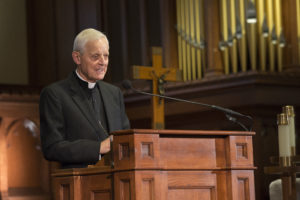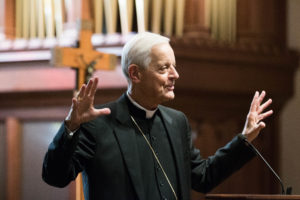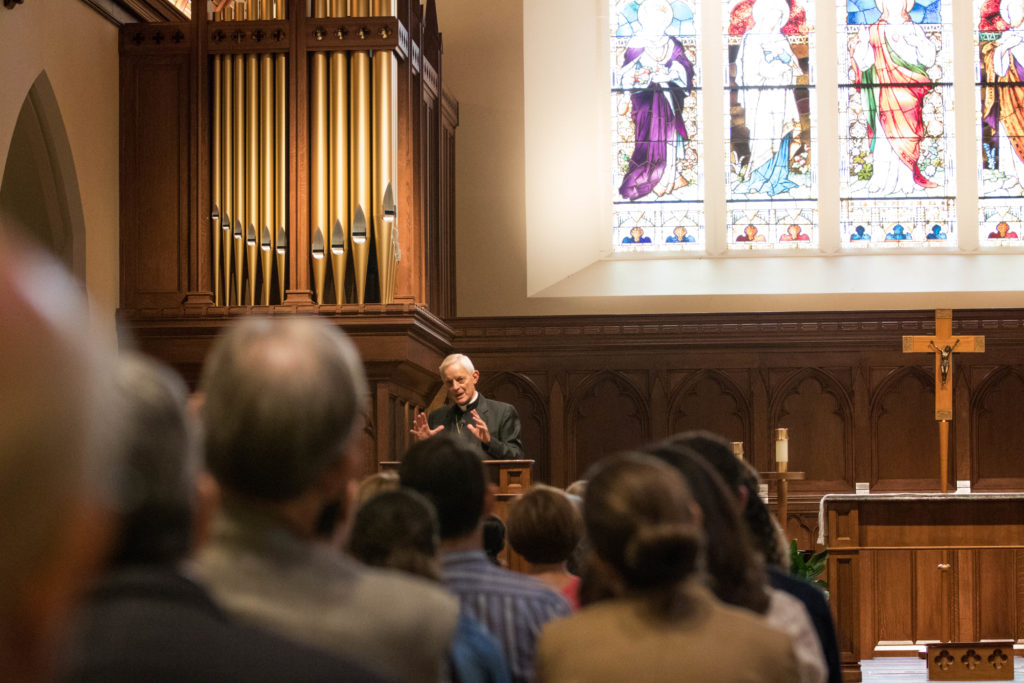
Read Cardinal Wuerl’s prepared remarks for the Lives Worthy of Respect Panel Discussion at Georgetown University on October 2, 2017.
Some years ago, I visited a mother who had given birth to sextuplets – six tiny bundles of life. As I gave a blessing to them, with pride in her voice and joy in her eyes, she described each child’s own identifiable personality even though they were so young and tiny that I could practically hold each of them in the palm of my hand.
How precious were each of those infants, as all babies are, not simply upon their birth, but beginning with their conception in the womb, made in the image of God and thus demanding of respect and protection from that very first moment.
But this is not always the message of our society. It certainly is not what is being heard by at least two generations of our fellow citizens.
Many years ago, I attended a meeting of representatives of civil government, police, education, philanthropy, social services, law enforcement, judiciary and faith communities. The topic was how to reduce youth crime and the violence associated with it.
At one point, a political leader addressed a question to one of the young people described as “at risk” who were already in detention or correction facilities. He asked a fourteen year old young man why at his young age he felt so comfortable with being violent to other people? I shall always remember the young man’s reply, “How come you get to draw the line?”
When the politician interjected, “What do you mean?” the young man continued, “How come you get to draw the line? You say it is all right for anybody to kill someone until they are born. How come you get to draw the line?” Another version of that question is: “Who put you in charge of who lives and dies?”
Today many accept the premise – advanced in the media, public schools and even civil law – that the value of human life is relative, and that people have the power to choose which lives are worth living and which are not.
What is the fruit of this culture’s “choice” mentality? Human life is increasingly held cheap as violence stalks our communities, suicide is on the increase nationwide, and in some states, instead of saving lives, there are physicians who help to end lives. The elderly and disabled, in addition to the unborn, are especially vulnerable in this climate.
Once you accept the thesis that it is all right to kill human life before it is born, or as it nears its end, or for some other reason, at almost any time you accept two premises: that we, human beings, have the ultimate say over all life and who gets to live, and that such a decision is ultimately arbitrary.
What we are witnessing today is a concerted effort to convince people that the sick and dying constitute a burden to their families and society, and therefore to regard those lives as not worth living. Such a view is of course antagonistic to the God-given dignity of all human life from conception to natural death.
At this point we need to examine the starting point of two diverse views of life that lead to these startlingly diverse conclusions about taking human life.
One view that for the most part was long recognized as the context for any life/death decisions saw all life as a gift from God. In this understanding, we spoke of “procreation.” Life was not something we could maintain indefinitely. At some point, all science, all medicine fails and life comes, in the natural course of events, to its natural end. So, too, with its beginning. Human life came to be through the marital act. It is not produced on a conveyor belt or in a technician’s lab. In this worldview, a child was not killed or “exposed to the elements” at birth if he or she demonstrated some defect.
What was accepted – grounded in God’s Revelation found in the Book of Genesis – was that God’s glory is manifest in all creation. Thus, children and adults with a wide range of capabilities and special needs are welcomed as God’s creation. Our annual White Mass at Saint Matthew’s Cathedral recognizes, as its foundational “given,” the Revelation that God, not we, determine the worth of each human life. Life. Life, as all creation, in its rich diversity is God’s gift.
Another view is far more directed by arbitrary decisions. The determination about the worth, value and quality of human life is made according to criteria established as politically correct and acceptable to a majority of voters. For example, in ancient Sparta, the martial Greek city-state, a male child deemed unfit for growth and training for military service was simply disposed of. Today an unborn child can be killed – aborted – because it is the “wrong” sex, or might possibly be less than what someone else determines as perfect.
The choice offered by assisted suicide, for example, is presented as kindness to avoid suffering and possible pain which many times is a euphemism for inconvenience for caregivers. It is a false compassion lacking true care and concern for the dying, as Pope Francis has noted. Instead of regarding suffering people as disposable and eliminating them, as one view asserts, we should accompany them with love and support them with access to better palliative care.
An element in our understanding of the value of human life is the cross. Catholic health care, in all its many manifestations, is an effort to extend the healing ministry of Christ. What we bring, however, is not merely the science of medicine and medical technology today, however good these realities are. We also bring an understanding of the need as members of the community of faith, to be with one another, support one another, particularly in the face of prolonged or even terminal illnesses.
These human realities we are invited to see as reflections of the cross. Jesus asks each of us to take up our cross and follow Him. It is our faith conviction that redemption came through the One on the cross. For this reason, we are asked to see in the cross we bear the signs of salvation and redemption. Clearly, the perspective is a horizon far beyond the limits of this natural life. It is one that opens up on to the glory of eternity.
When asked what does the Church bring to the world of technology, political correctness and satisfied self-assurance, our response must be that we bring what we have always brought. We bring an invitation to faith, a respect for God’s creation and His created plan. We offer an introduction to the Gospel and its values. Most importantly, we present the opportunity for an encounter with Christ and his compassion and mercy.
A beautiful example of this truly merciful response to illness and suffering was offered by Saint Marianne Cope, whose feast day we celebrate today. Following Saint Father Damien of Molokai, she embraced and provided loving care and hope to the wretched patients who had previously been given only despair by society when they were banished to the Hawaiian leper colony on Molokai.
When we speak of respect for human life, it is easy for us to get caught up in abstractions, and our response can seem somewhat theoretical. But our obligations are quite concrete. Lives depend on us.
A number of years ago, I had the opportunity to visit a maternity hospital in Peru that was supported and sustained by the Church in this country. It operated in an impoverished area with a large, struggling population of poor and needy people.
One of my greatest joys is when young parents give me their newborn baby to hold, so I was delighted when the sisters running the maternity ward invited me to hold one of the children under their care. As I gingerly picked up a one-day-old infant, the baby latched onto my finger with all his strength and held tight.
That infant is a parable to me – a representative of countless unborn children reaching out to hold onto you and me, reaching out with all their strength. In their struggle to find a place, a home, a life in this world, the most vulnerable among us depend on us to work for a culture of life.
It is said that silence and ignorance are allies of evil and this is certainly true with respect to abortion. So ingrained and commonplace is the mentality and practice in our society that many have become inured and numb to the violence. Moreover, so staggering and beyond comprehension are the nearly 60 million innocent unborn children taken in abortion since the 1973 Roe v. Wade decision that they risk becoming just numbers. However, these are not mere statistics on the page. We are talking about real human lives and the loss of each one is an alarming tragedy.
What is even more alarming is the call of some pro-abortion organizations “to celebrate abortion.” Just as we would celebrate a new born child – what we used to refer to as “a blessed event.”
This is why we cannot be silent. This is why we dare not turn our attention away. We pray and march so that these innocents will have someone who will speak for them. We labor in order that unborn children will not be ignored, forgotten, invisible to people’s consciences, to remind the nation that behind the word “abortion” and euphemisms like “choice” and “reproductive health” are real human beings.
We need to ask those who say they are in favor of “choice” to complete the sentence. Choice of what? Cigarettes in public restaurants, funding for the school for your kids? The list can go on and on!
Our witness must be the voice that awakens our society to the emptiness of telling women that abortion is the answer to their problems. We must work for the right to life and bring hope and healing to those women and men who are or have been in crisis situations. May God give us all the determination to build a culture of life, defending the life and dignity of every human being from conception to natural death.
During Pope Francis’ visit to Washington, one of the most striking images was how the Holy Father’s love radiated whether he was greeting a head of state or a homeless person. His gestures, his words, his actions in every encounter proclaimed the truth that every life is worth living. As a gift from God, every human life from conception to death is sacred. It is this fundamental truth the Pope so convincingly communicates.
October is Respect Life month. During this time, in a special way, people are invited to reflect on the ways they can give witness to the dignity of every human life. “In many places, quality of life is related primarily to economic means, to ‘well-being,’ to the beauty and enjoyment of the physical, forgetting other more profound dimensions of existence – interpersonal, spiritual and religious,” observes Pope Francis. “In fact, in the light of faith and right reason, human life is always sacred and always ‘of quality.’ There is no human life that is more sacred than another – every human life is sacred.” (Address of November 15, 2014).
The Church has always proclaimed the dignity of each human person. In our day when we hear so much about renewing the inspiration of the Second Vatican Council, we must also remind ourselves of what it said as it stressed how human life must be honored and upheld, fostered and respect: “whatever is opposed to life itself, such as any type of murder, genocide, abortion, euthanasia, and willful self-destruction . . . all these things and others of their like are infamies indeed” (Gaudium et Spes, 27).
Thus, there is great need now as much as ever for faithful disciples of the Lord and members of his Church to give ready witness to the dignity of human life at every stage, including our efforts to bring hope and healing to those who are or have been in crisis situations, leading to pain and despair.
For example, for more than 25 years the archdiocese’s Project Rachel Ministry has helped women and men heal spiritually and psychologically from the pain of abortion. Please take a minute to go here to learn more about this blessed work.
The archdiocese has also created a variety of #TransformFear resources that address the questions related to the end of human life due to illness, age or injury. With Pope Francis warning us of the “throwaway culture,” we must remember that human life is a gift from God – there is no such thing as a life not worth living. Our response as family members, as caregivers, and as a Church to those facing the end of life – with all their feelings of isolation, fear, and burdensomeness – is genuine compassion and reciprocal love, which seeks to provide comfort and hope in the face of fear and suffering.
One manifestation of support for life is found in what has become for decades an every year event, which welcomes new generations of participants.
Preceded by the morning Youth Rally and Mass for Life hosted by the Archdiocese of Washington, in the March for Life hundreds of thousands of voices are raised to announce the truth that every human life is sacred. What is so encouraging to me is the huge number of high school and college students who participate. While many of these young people are local, there are also many who have endured long bus rides from destinations all over the East Coast and Midwest, and wherever they are from, they are willing to stand outdoors for many hours in generally less than welcoming weather conditions.
Even more impressive, for many of them, their participation in pro-life advocacy does not begin and end with the Rally and March – it is a year-round commitment to human life, something that is part of the fabric of their lives.
Dear friends, what we bring to our culture, our society, our community today is not just the very significant call to respect all life. What we also offer people is hope – the Good News that God exists and our existence is not random or accidental. We are not at the mercy of arbitrary forces; chaos does not rule the universe. Rather, we exist because God brought us into being and breathed life into us (Genesis 2:7; Jeremiah 1:5).
I want to conclude with one last story. Some years ago, when I was on pilgrimage to Lourdes, I watched as the Eucharistic procession wove its way through the huge crowds. At one point, a young woman in a wheelchair struggled to stand, bracing herself by holding on to the arms of the wheelchair. She strained to remain standing until the Blessed Sacrament had passed in front of her. Then, exhausted from the effort, she slumped back into her chair. Some things are worth standing for, even if it takes effort.
My brothers and sisters, let us always be prepared to stand for the gift of life. Let us be ready to stand for those who cannot yet or can no longer stand for their own life. Let us stand in the strength and gift of our own life in order that we can always be a witness to our message: That all life is sacred because it is a gift from God.




